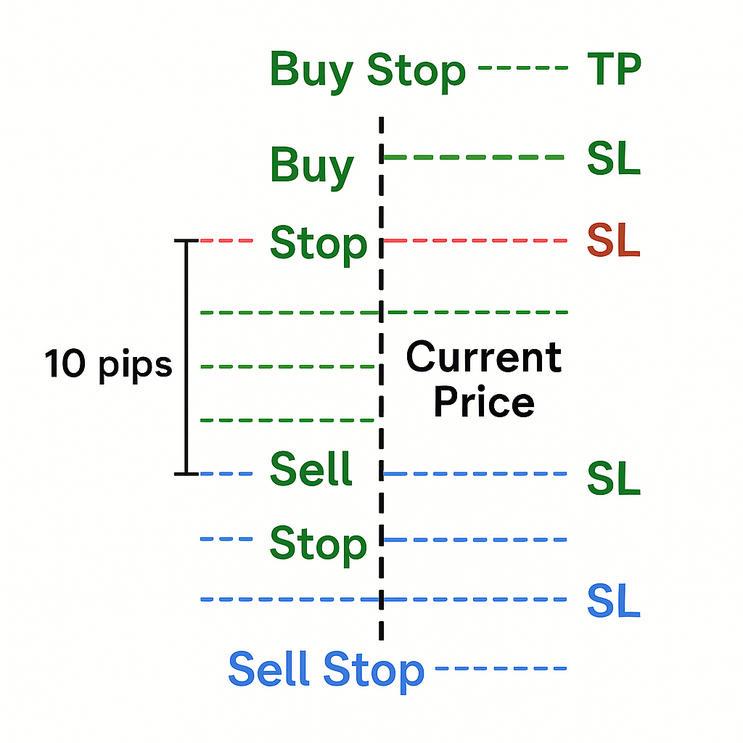12# Grid Breakout Forx Strategy
Dimitri 2025
Grid trading is a breakout-based trading method that allows consistent profitability even in uncertain or ranging market conditions. This article outlines how to set up buy/sell orders, manage positions, and maintain discipline using a structured grid approach.
Who This Strategy is For
This method suits:
-
Full-time workers who can't monitor charts constantly.
Traders who enjoy passive order setup.
People tired of complex indicators or chart analysis.
Traders who can handle temporary losses while waiting for breakout gains.
Strategy Overview
This strategy is based on two principles:
-
Markets always range before breaking out.
Setting Up the Grid
Example: EUR/USD Short-Term Grid (10-pip spacing)
-
Determine Grid Size:
-
Choose based on the pair’s spread. For EUR/USD (low spread), use a 10 pip grid.
-
-
Place Buy Stop Orders Above Current Price
-
Example: If price = 1.1000.
Place Buy Stops at: 1.1010, 1.1020, 1.1030 … up to 200 pips above.
Each with:
-
Stop Loss (SL) = 10 pips below entry.
Take Profit (TP) = 30 pips above entry.
Risk = 0.5–1% per trade.
-
-
-
Place Sell Stop Orders Below Current Price
-
Example: 1.0990, 1.0980, 1.0970 … down to 200 pips below
Each with:
-
SL = 10 pips above entry;
TP = 30 pips below entry;
Risk = 0.5–1% per trade.
-
-
Position Management Rules
1. Breakout Trigger
-
As soon as price breaks out (up or down), one side will trigger.
If price trends 100 pips in one direction, you may hit multiple TP levels.
Let all triggered trades run to TP or SL—no manual intervention needed.
2. Re-Entry
-
Once a position hits TP or SL, place a new trade on the next available grid level.
If price moves into a new 10-pip zone, place fresh Buy/Sell Stop orders outside the current price range.
3. Ranging Market
-
In ranging markets, losses may accumulate from multiple false triggers.
These losses are covered by one clean breakout, which hits 2–5 TPs at once (net positive).
Money Management
-
Risk only 0.5% to 1% per trade.
Use fixed lot sizes based on account balance.
Avoid overtrading by capping trades to:
-
20 Buy Stops
-
20 Sell Stops
Review and reset your grid every 6–8 hours
-
Example Performance
|
Trade |
Type |
Entry |
SL |
TP |
Result |
|---|---|---|---|---|---|
|
1 |
Buy Stop |
1.1010 |
1.1000 |
1.1040 |
+30 pips |
|
2 |
Buy Stop |
1.1020 |
1.1010 |
1.1050 |
+30 pips |
|
3 |
Sell Stop |
1.0990 |
1.1000 |
1.0960 |
-10 pips (SL) |
If the market trends upward, Buy Stops win big. The few stopped Sell trades are recovered by multiple winning Buys.
Grid Timings
-
Set new grid levels at:
-
7–8 GMT
-
13 GMT
-
18–19 GMT
-
-
Reset every day or week based on volatility and trend.
Final Notes
-
Backtest and demo-trade before going live.
Use pairs with low spreads (EUR/USD, GBP/USD, USD/JPY).
Expect 10–20% monthly returns with discipline.





